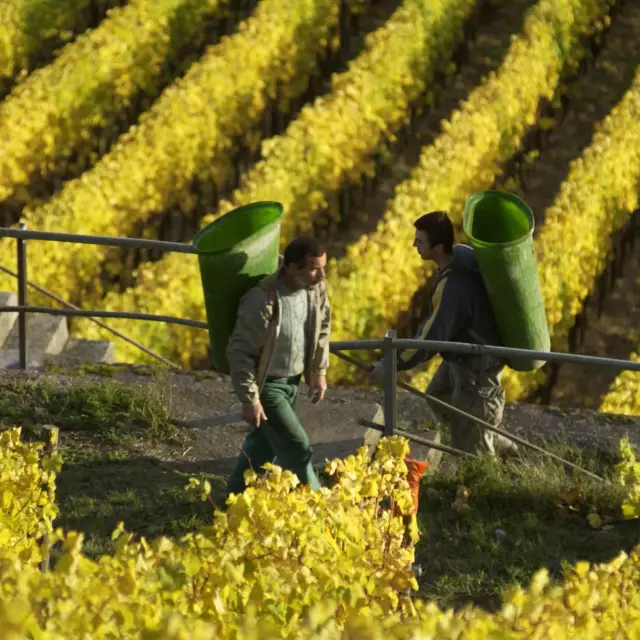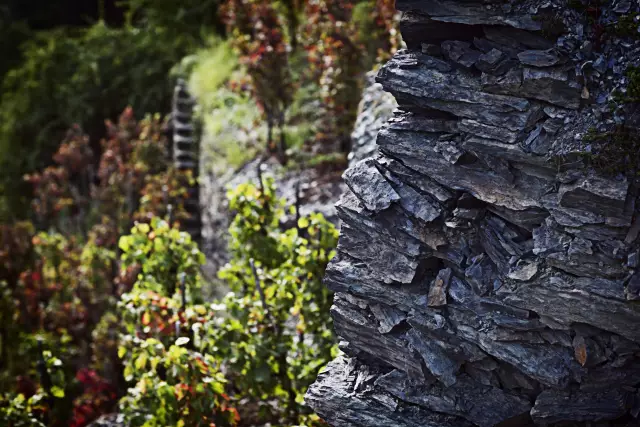Work in the vineyard

It is a long way from the vine in the vineyard to a wonderful wine.
Facts
-
> 300° Öchsle
are qualified for the making of Trockenbeerenauslese (TBA)
-
8,9 Mio
hectoliters were harvested in Germany in 2022
Work in the Vineyard
Many stages of work are involved before a finished bottle of wine reaches a consumer. Throughout the entire year a wine-grower has various tasks to tend to, such as training and pruning the vines, soil care, foliage treatment and thinning, as well as harvesting the grapes as selectively as possible.
New developments in viticulture and cellar technology during the past few decades have enabled the German wine industry to flourish. Thanks to intensive research in recent years, there have also been decisive improvements in the overall quality of German wine. Justifiably, one can say that the amount of really excellent German wine produced today is unprecedented.
Spring
Usually, in January and February, the old wood is pruned away, a procedure that definitely influences the potential yield and ultimately, the quality of the wine. The number and length of canes and their shoots also play an important role. Quality-conscious growers generally reduce the number of canes per vine to two short ones or one long one. Many growers have come to realize that today, with a worldwide surplus of wine, quality is a vital competitive factor and quality begins in the vineyard. Vine prunings are usually mechanically chopped or crushed, then worked back into the soil to improve the humus supply. To this day, pruning by hand remains a very labor-intensive task. It takes large estates several weeks to complete this work.
Vineyard activities peak in the springtime. Before bud-burst, the vine's shape takes form through bending and tying the canes in order to ensure an adequate nutrient supply to the shoots. Plowing and seeding for green covering, as well as the natural growth of plants in the vineyard, brings the soil to life. Organic nutrients, e.g. manure, straw or compost, as well as supplementary minerals, e.g. magnesium, calcium or phosphate, are also added at this time. Today, economical and environmental factors play a great role in how vineyards are fertilized. Modern methods of soil analysis easily help determine where there are deficits. Carefully planned fertilization and green covering also help avoid ground water pollution.
"As little as possible, as much as necessary" is the motto of modern wine-growers with regard to spraying to combat vine pests and fungus disease. Starting with healthy vines, i.e. planting vines that have been grafted onto suitable rootstock, for example, also helps reduce the incidence of disease and damage.
Summer
Another labor-intensive phase begins after blossoming in June. Ideally, the blossoming period, the self-pollination phase that leads to berry formation, is not prolonged. This could result in coulure (blossoming without fertilzation) or millerandage (development of uneven-sized berries). Insufficiently fertilized blossoms wither and/or drop off in windy or rainy weather, and thus, seriously reduce the yield. Removing unwanted shoots promotes growth. Growers also prune clusters in order to reduce yield and thus, improve quality.
Between June and August, a thick leaf wall develops that is kept in shape by tying or binding the shoots. Healthy, i.e. green, foliage is very important for assimilation in the leaves. Nevertheless, some of the leaves must be removed in order to increase sun penetration and improve air circulation. Leaf pruning in July and August also regulates the height of the vine. Today, this work is usually done by machine.
In July and until the beginning of August there are still means of influencing the quantity and quality of the grapes. Thinning out some of the pea-sized berries strengthens those left on the bunch. More and more growers are using this method to improve quality.
Autumn
Starting late summer, the grapes clearly begin to ripen. The amount of sugar in the berries rapidly increases as the acidity decreases (particularly the malic acid; the tartaric acid is retained).
Harvest
This is certainly the most exciting moment for the winemaker and when it is seen whether all the efforts to maintain the vineyard will be rewarded with a successful wine. When a wine is ripe for harvest depends mainly on the type of grape and the weather. Ultimately, the winemaker determines when the grapes find their way into the cellar, estimating the weather risk and planning which grapes to press when. On the one hand, a wine can get better when the plant has a long time to ripen the grapes. On the other hand, a sudden frost or a rainy season can jeopardise the harvest.
The higher the desired wine quality, the more important the question of whether to harvest by hand or by machine. Handwork enables precise selection: only the ripe grapes are taken and the rotten berries can be cut out of the bunch. Sometimes one has to walk through the vineyards over several days and only cut off the ripe grapes. Thats obviously expensive. A mechanical harvester, on the other hand, saves time and money. The principle: The grapes are shaken down by vibration and caught. If the harvester is set correctly and the grapes are optimally ripe, this way of harvesting is very gentle and doesn’t necessarily mean a reduction in quality.
Can the winemaker simplify one of the most tedious tasks in the vineyard - pruning?
Pruning can be partially or even completely eliminated - if the conditions such as the age of the vineyard, the width of the rows, the desired quality, etc. are matched. This is called minimum or no pruning, but opinions differ.




